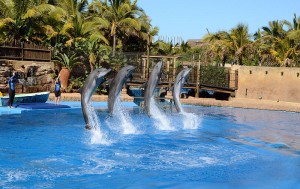INBREEDING CONTROVERSY MAKING WAVES FOR USHAKA SEA WORLD
The recent birth and death of a nine day-old Bottlenose dolphin, named ‘Baby’, at uShaka Sea World in South Africa, has sparked tremendous upset and controversy throughout the marine conservation community.
Given there is only one other male dolphin in captivity at uShaka apart from the original wild caught male, Gambit, that is not a progeny of Gambit and Frodo, the original wild caught female, we can confidently assume that inbreeding transpired.
Supporting this assumption are several uncorroborated posts on social media sites citing Gambit as the father. In addition we know that uShaka Sea World performs around the clock monitoring of all their dolphins so they should know who the father of the calf is.
Despite the obvious, it is highly disturbing that uShaka Sea World is blatantly lying to the public, having spokesperson Gavin Drysdale state in an interview on East Coast Radio that “Baby’s paternity was a mystery” and in a follow up interview after Baby’s death he said, “Our scientists and biologists are totally assured that there are no inbreeding issues here. We do manage the population well and we fully understand how the dolphin pods work [and] how their reproduction happens in the wild. In this case, the baby’s demise was definitely something else.”
While inbreeding is not unheard of in the wild, according to a study of bottlenose dolphins found in East Shark Bay, Western Australia, by Céline H. Frère, Michael Krützen, Anna M. Kopps, Patrick Ward, Janet Mann and William B. Sherwin in 2010, “inbreeding tolerance is expected to evolve where the cost of avoidance exceeds that of tolerance”. This is surely so and unavoidable at uShaka Sea World where 11 dolphins are living socially in close proximity in what could be compared to a small pod in the wild.
According to the East Shark Bay research team, in the Western Australian pod they studied, it was the females’ earlier calves that were most likely to be inbred, so it is not surprising that Khethiwe is the mother of the calf that died. At six years-old, Khethiwe is the youngest of the dolphins at uShaka Sea World and as such lacks the experience and the ability to avoid mating with a family member.
Unnamed sources claim that uShaka Sea World attempts to simulate natural living conditions as closely as possible. They also allow their dolphins to have as much natural social interaction as they can in an unnatural environment. This means that the dolphinarium’s dolphins interact with each other just as they would in the wild and as a result unintentional breeding and therefore inbreeding is highly likely to occur. The most recent example of this is Baby – she is not the first and probably will not be the last.
We believe there have been other unsuccessful births and pregnancies in the past that have been kept secret from the public. No official details of whether a breeding programme is in place or not have been obtained from uShaka Sea World by any marine conservation organisation. However given the state of financial affairs of uShaka over the past few years, we believe that it is not in uShaka Sea World’s best interest to purposefully breed any more dolphins. The cost of food, medical assistance, water maintenance and so on needed to care for and house the existing dolphins is astronomically high and ironically it is uShaka Sea World’s contentious dolphin shows that bring in the money to care for the dolphins.
So, if this is the case and uShaka Sea World does not want to breed any more dolphins and marine conservation organisations do not want to see any further breeding in captivity, how should uShaka Sea World prevent unintentional breeding from happening again?
Separating the dolphins is not the answer, as this will inevitably cause unwanted stress between the captive “pod” members and could also be deemed cruel to do so. Contraception for female dolphins may be the answer, but first we need to understand whether sufficient studies have been done to know how safe contraception in Bottlenose dolphins is. Do we know what dosage of hormones can safely be administered without causing any harm? Can contraceptive hormones lead to the development of cancer or have other unforeseen consequences?
We can justifiably say that being stuck with all these challenges and more at uShaka Sea World is a prime example of why captivity of dolphins is just plain wrong. No matter how one views uShaka Sea World’s situation and no matter how well they appear to look after their dolphins, with trainers who genuinely love and care for them only wanting the best for them, with entertainment shows where the hoops and “circus-ness” have been replaced with shows incorporating movements that mimic those performed in the wild in state of the art pools. and with probably some of the best captive conditions in the world, captivity just does not work.
www.facebook.com/EarthraceAfrica
